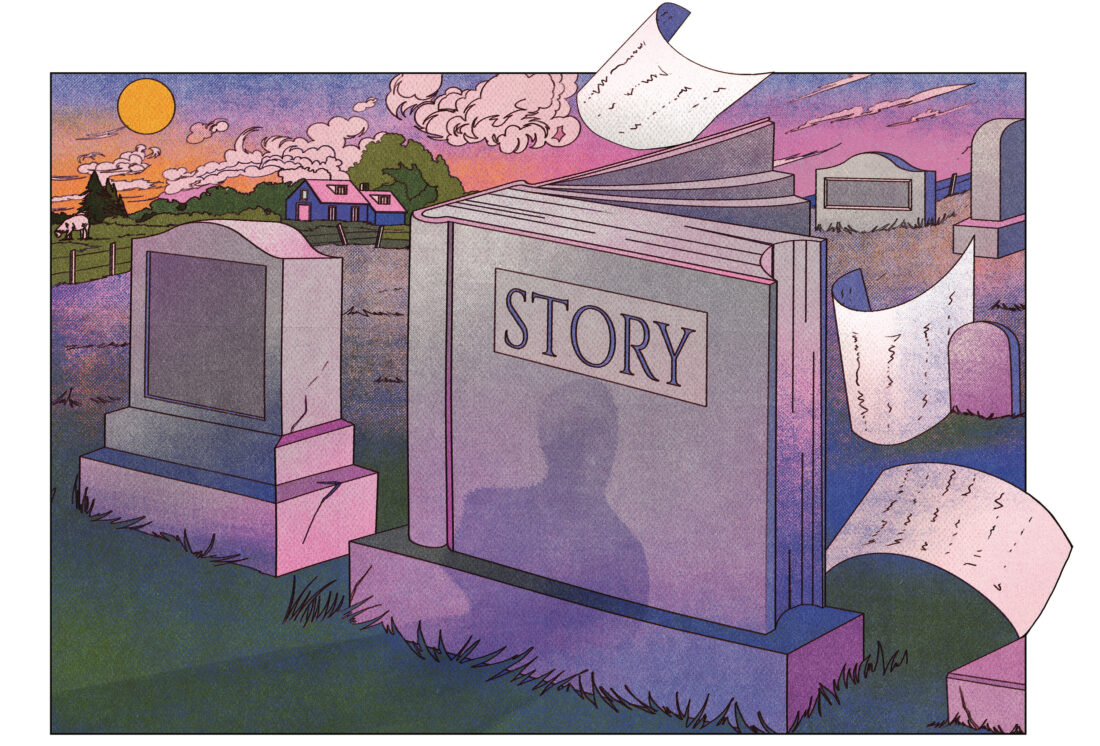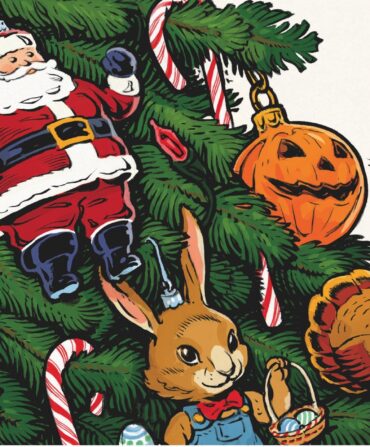It is a scene that would feel hopelessly contrived in a novel: A church cemetery borders a family farm, and only a barbed wire fence separates the two. During a bad storm, the wind blows a wreath off a grave and into the cow pasture. A grandmother sends a child, who one day will become a writer, to place the wreath back on the proper side. He must do this respectfully, his grandmother tells him, so instead of merely dropping it back over, he slips through the barbed wire to set the wreath at the entrance. Before leaving, the boy pauses to read what is chiseled into the stones. Nearly all have birth and death dates and full names, but at the center of the front row sits a stone with only a last name: Story.

I was the child. Laurel Fork Cemetery near Boone is part of the Aho community of Watauga County, North Carolina. The names across headstones include neighbors and kin—members of the families Greene, Triplett, and Story. Located atop a hill, the cemetery offers a postcard view of the Blue Ridge Parkway and the mountains that rise beyond. It is also the one place that gives a full view of my grandparents’ farm.
In 1979, my widowed grandmother died, and her eight children divided the family land. My mother’s inheritance included the sloping pasture that bordered the cemetery, but she lived sixty miles away and had no practical use for the acreage. However, she wanted to keep it in the family, so she paid the property taxes each year and let the pasture remain as it was.
In the years since then, I’ve enjoyed spending time on the land, mostly sitting and looking out at the mountains. Before leaving, I usually cross through the barbed wire and into the cemetery. Most of my family, including my grandparents and now my parents, are interred a mile and a half away at Friendship Methodist Church, but several of my relatives are buried at Laurel Fork, including Conor Triplett, who, as his marker tells, was killed during World War II in North Africa. To visit the cemetery is to acknowledge my family connection with him and the others. I can also look below and contemplate what has not changed in the landscape and what has.
Aho Road divided my grandparents’ farm. The portion across the road from the house was woods and a meadow, coursing through it the creek where I caught my first trout. What I remember most about the place is its summer brightness—rhododendron blossoms, goldfinches, the speckled trout. Even the creek’s glittering tumble over the rocks. This is a place I still dream about, especially in times of stress. After my grandmother died, most of the farm remained in the family, but the woods and meadow were sold, the acreage transformed with houses. Writers often seek to preserve what might otherwise be forgotten, so it’s not surprising that in the years soon afterward, in my late twenties, I would want to re-create the farm with words.
Up to the early eighties, I’d written only stories and poems, but a novel’s wider canvas seemed right for a place so important to me. I thought of the gravestone’s looming presence above the farm. A story is down there, so tell it. But what was the story? My poems and stories almost all began with a single image—a rusty harrow-plow, a mill’s water tower. I did not have that image, but I had my own memories to draw upon. I wrote 250 pages, constructing events that never sparked with the vitality that caused D. H. Lawrence to proclaim a successful novel “the one bright book of life.” I threw the floppy disk (remember those?) into the trash can.
I made one more attempt a year later. This time I did have a story, inspired by an actual event. A friend told me about an incident that had occurred in the rural South during wartime. Against his parents’ wishes, a young man married a woman his wealthy, socially conscious family believed was beneath them. After the husband was drafted and sent overseas, the wife suddenly died. The parents told the man that his wife perished of natural causes; rightly, many people in the community suspected otherwise. A perfect story for a novel, I thought, but each time I tried to write it, again centering the pages on my grandparents’ farm, the result was no better. I’m not a novelist, I told myself. I didn’t try again for fifteen years, not realizing that what was true for my poetry and short fiction was also true for novels: Characters, time, and place choose you, not the other way around.
In my forties, images came that poems and short fiction could not satisfy. In the next two decades, I wrote seven novels, but none took place in Aho. I had set plenty of poems and stories there, though, and accepted that they would have to do. Then, seven years ago, an image came of a black-veiled woman kneeling before a marble tombstone. The cemetery was Laurel Fork, and I almost instantly realized something else. The woman—or was it a ghost?—had come at night to mourn at her own grave.
An excellent opening for a novel, I decided, to draw in the reader. I wrote that scene, two pages in italics, and moved on. The early chapters alternated between the farmhouse below the graveyard, where the parents and daughter-in-law were, and those of the husband fighting in Korea. The cemetery remained hidden on the ridgetop. But the novel kept stalling. Then, ever so slowly, I realized the novel’s principal character was neither the wife nor husband nor a parent, but instead the cemetery’s caretaker, who would discover the plot behind the wife’s demise. The story was where it had always been, in the cemetery.
Few novelists I know can fully explain the origins of their books and why so often their narratives feel as much found or transmitted as created. Fred Chappell once described writing fiction as like a radio tower receiving signals from the ether. This tapping into a source that is somehow “out there” is a Jungian notion that feels right to me. Nevertheless, my new book, The Caretaker, of all the novels I’ve written, has the most obvious origin. Perhaps a more mysterious aspect is why I took so long to link the gravestone and a factual incident that had intrigued me for decades. But there is one thing that I do find uncanny. Last year, as the novel finally neared completion, I called my friend and told him that what he’d shared about the soldier and murdered bride became the basis of my new novel. I’ve never heard of such an incident, he assured me, and further demurred when I asked if he was certain. It had to be someone else. Who could forget a story like that?
My mother died last September. After the funeral, I walked up to the top of the pasture. I did not enter the cemetery but stood by the barbed wire and looked below. More changes have come, including to my grandparents’ house, which has now fallen into disrepair, but I have ensured that at least this pasture will remain in my family for another generation. I doubt my children will build on this land, so it will remain as it is, a place from whose vantage what I can no longer see, I can at least remember.
Garden & Gun has an affiliate partnership with bookshop.org and may receive a portion of sales when a reader clicks to buy a book. All books are independently selected by the G&G editorial team.








